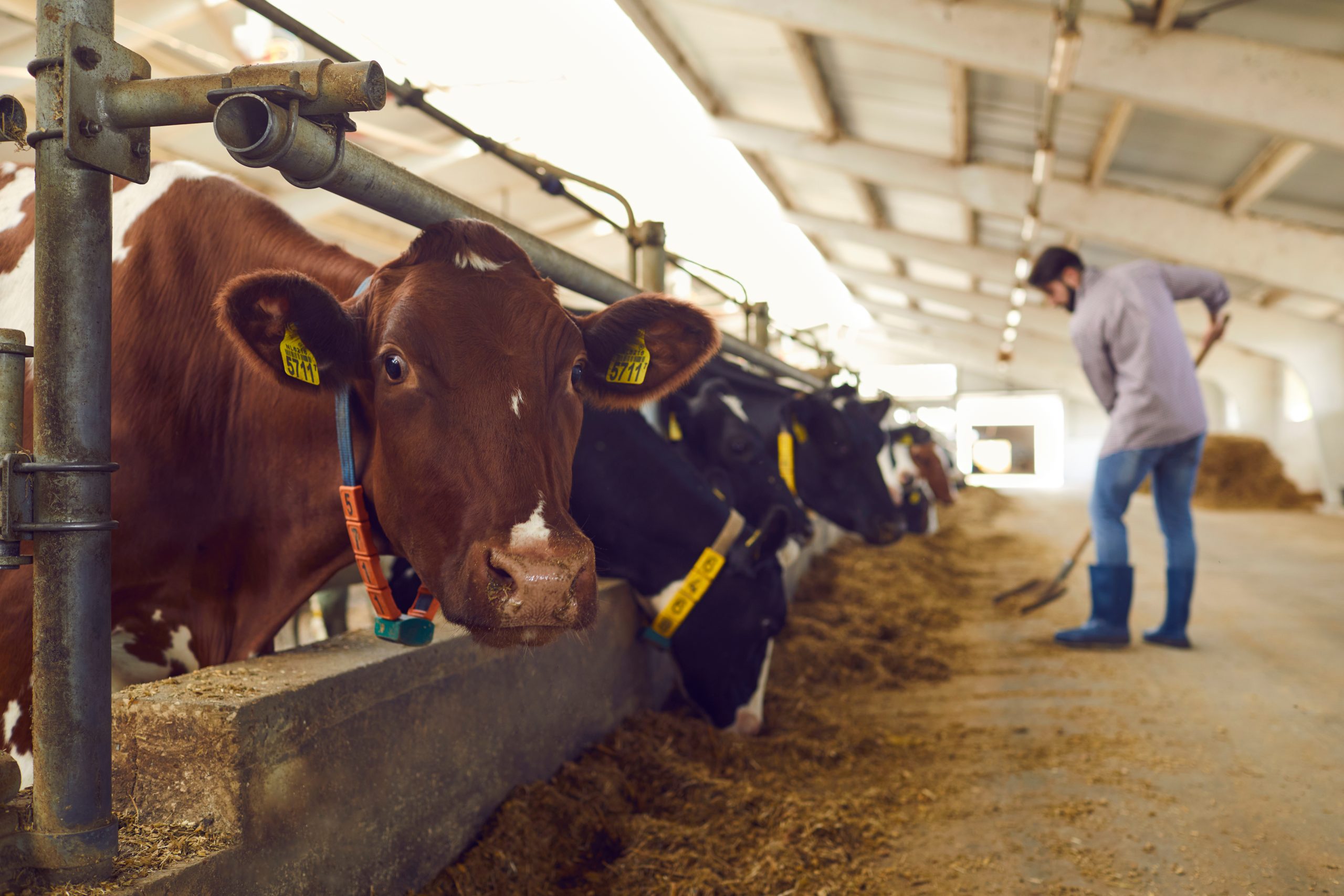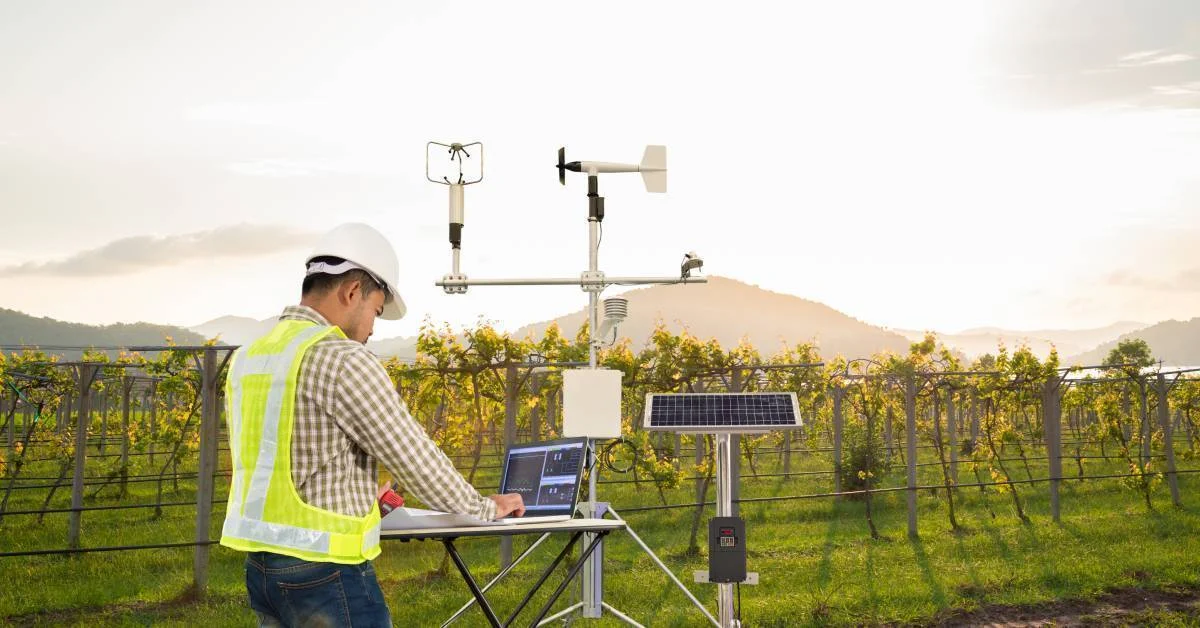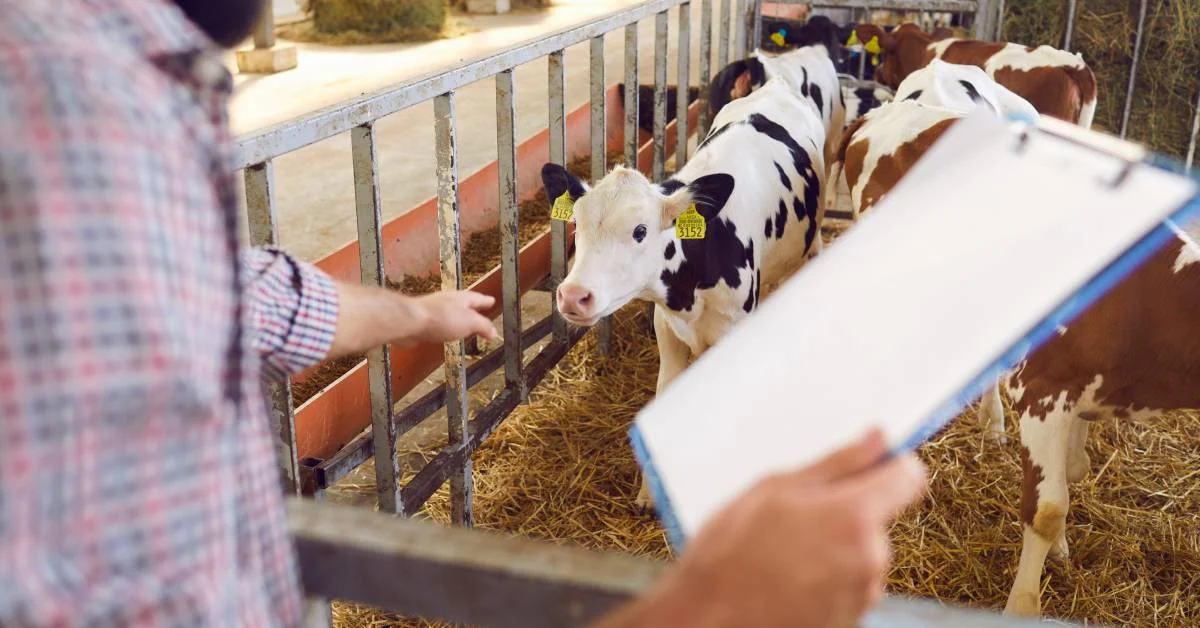Livestock has long been one of the most important assets people have owned. It is a source of sustenance and several by-products. The most prominent livestock are cattle, i.e., cows, bulls, and calves.
Cattle is also the most lucrative, owing to how much they can produce. Research shows that livestock markets are projected to grow at a rate of 15.4% between 2023 and 2032.
It’s important to have a plan before entering the cattle farm business. This is much easier said than done, but you’re in the right place, and we cover everything you need to know in detail.
There are several factors to consider, chiefly consumer preference, logistics, and competition. The following steps walk you through how to start a cattle farm. You also learn how to farm cattle, among many other areas.
Researching the Cattle Farm Industry
Before any business takes off, the owners need to research what is a cattle farm. This research lets the owners know what the industry is like, the dos and don’ts, the pros and cons, how supply and demand works, and so on.
The cattle business is no different. Before starting cattle farm businesses, owners need to research the industry.
Researching the cattle industry helps owners look into the likes of:
- The supply chain situation.
- Costs associated with running the business.
- Identifying profitable breeds of cattle.
- Identifying the different niches to work with.
- Learning of the existing competition to identify:
- Analyzing their scale of operations.
- Identifying what breeds of cattle they work with.
- The scale of production.
- Learning how cattle farm social media operates.
- How to work with third parties and other farmers.
The importance of this research cannot be understated. Every prospective business owner must know what they’re getting into before they start. The cattle business is incredibly demanding, with several facets working together to make the wheels spin. This research allows businesses to understand demand and how to meet it.
Additionally, the requirements and benefits of these structures can vary depending on the state, so it’s important to gather state-specific information before making a decision. For example, forming an LLC in Wyoming offers low fees and strong privacy protections, while Delaware is known for its business-friendly legal framework but has higher fees and more complex requirements.
Pick from dairy cattle farming, beef cattle farming, cow-calf operations, feedlot operations, veal farms, or ranching. In the beginning, you want to pick one and go with that. The competition in this space is tough, so pick one with a relatively low barrier to entry.
Creating a Cattle Farm Business Plan
After conducting all the necessary research, it’s time to get to business. This includes creating a plan of action and getting your business started. A cow farm business plan is tasked with creating a sense of direction and assigning roles to everyone and everything. If you’re unsure where to begin, you can also explore the best online essay writing services to help structure your plan clearly and professionally especially if you’re pitching it to lenders or investors.
However, you can even write your business plan with the help of an Ai business plan generator, still here is an outlook of what they look like
Summary
This section details the mission and objectives of your business. It touches on different variables responsible for profit and loss. It details the net income needed to break even and eventually hit profitability.
Creating the right objectives ensures the business operates as it should and moves in the right direction. Business objectives should follow the SMART methodology. They should be simple, measurable, achievable, relevant, and time-bound.
This way, the business knows what to do, whether it can be done, whether the objective is viable, and how much time it has to work.
Business Overview
This section details the business summary, ownership (names and percentages), relevant history, and past business performances. It outlines the business structure and how different areas of the business operate.
The business overview also mentions whether it is a sole proprietorship, partnership, limited liability company (LLC), or corporation. Different types come with various tax and legal structures and advantages.
The Products
This section mentions the products being sold, any variations, and derivatives. For example, you have dairy products, beef, or hides. Businesses need to sell a product that others are willing to buy. It must also be in demand all year round and not compromise on quality.
The business needs to consider different cattle breeds. Each breed comes with varying maintenance requirements and benefits. These breeds should be readily available around the business, receptive to the diet available, and work with the climate where your farm is.
Market Analysis
This section summarizes the state of the market. It also details the different segments it is divided into, its target markets, and how to pitch your product to them.
You can also find consumer buying patterns and competitor analysis that let you know what you’re against. Starting cattle farming is one of the most essential parts of the process.
Business Strategy and Implementation
This is one of the more critical sections of your cattle farm business plan. It includes your business’s SWOT analysis and competitive edge.
Your marketing strategy, detailing how you plan to reach customers, is also mentioned. Knowing your ideal customers (individuals, processors, or distributors) is essential.
This is followed by the sales strategy, which covers your sales forecasts and channels. These identify ways to get to where the business is projected regarding revenue.
Toward the end, you have a comprehensive budget detailing all essential expenses, i.e., feeding and treating animals, salaries, and overhead costs.
The Financials
This section talks about all things money. It details any critical assumptions regarding business, the break-even analysis, a projected P/L, cash flow, and balance sheet. You will also find any business ratios used in this business plan section.
The financial information pertains to the startup costs, operational costs, revenue projections, and profitability analysis.
Choosing the Right Location and Setup
Your cattle farming business must have suitable livestock breeds, equipment, infrastructure, and location. These factors will directly affect your business’s production, sustainability, and scalability. You need the right location, properly maintained livestock, and the infrastructure to tie this together.
Farm Location
Picking the right location for your cow business is essential due to several factors influencing its outcomes. The factors include:
The Climate
You need a suitable climate to meet your chosen cattle breed goals. Having favorable temperatures, humidity levels, and precipitation in the air is essential. Each of these plays a vital role in the short and long-term success of your cattle farm business.
Grazing Spaces
The cattle farm needs adequate grazing spaces to satiate the demands of its livestock. It also needs sufficient access to suitable pastures and rangeland.
Furthermore, it is vital to consider the land’s carrying capacity (ability to sustain your livestock), soil quality, and whether additional feed sources are needed. If you’re looking to expand or establish your farm, you can explore land for sale in Edmonton or nearby areas.
Water
Your cattle farm needs to be located near a consistent supply of water. This is to satiate cattle drinking needs and other farm processes. It is used by farm staff to keep the place clean, ensure the fields are watered, keep the animals clean, and also for personal use.
Access to the Market
Being close to different markets allows you to easily participate in other auctions, be near various processing facilities, and save on transport costs. This results in better product delivery times, keeping farms and customers happy.
Building and Maintaining Facilities
Modern cattle farms combine age-old experience with the latest technology and infrastructure. You want your farm to have as good a facility as possible. Make it a point to research local zoning regulations.
This lets you know whether you’re allowed to run a cattle farm where you are. The most important features of your cattle farm include:
Barns
Your livestock needs proper protection from the elements. It must be hygienic, adequately ventilated, and have an appropriate waste disposal system. These barns don’t look like the big wooden ones you see in movies and are much larger and modern than those.
Milking Parlors
A proper hygienic and functional milking parlor must be set up if you intend to sell dairy products. The animals need to feel comfortable during milking for optimal production of high-quality milk.
Fences
The last thing you want is your expensive cattle escaping the farm or getting stolen. They are also at risk from predators that see a healthy prey source. Counter this by picking a sturdy material to build fences around your complex. This keeps the cattle and farm staff in and predators or thieves out.
Handling Facilities
Your cattle need proper handling for transport, sorting, or veterinary care. Chutes, corrals, and specialized loading areas were used to ensure no hurdles were in the way. Improper facilities can hurt the cattle, hurting your business.
Proper Cattle Farm Infrastructure
Your cattle farm infrastructure must focus on water, power supply, and adequate waste management. Building or planning your farm infrastructure around this ensures smooth operations with minimal hiccups.
Proper Water Supply
The cattle farm always needs a consistent and abundant supply of clean water. This is to ensure the cattle have more than enough to drink. The farm must also be kept clean to prevent disease ravaging the cattle – every farmer’s worst nightmare.
Adequate Power Supply
Cattle farms employ various machines to keep operations running smoothly. This includes all operating equipment, various outdoor pendant lighting sources, climate control systems, and ventilation systems. An adequate power supply ensures that all of this works as needed.
Waste Management
Your waste management system must include ways to store all the manure your cattle produce. Waste disposal systems are also needed to ensure hygiene and compliance with environmental regulations. Proper waste management also prevents the development and spread of different bovine diseases.
Acquiring Cattle and Managing Livestock
The cattle breed you pick depends on what sort of business your cattle farm will do. When acquiring cattle, focus on selecting the right breed, purchasing options, and understanding husbandry.
Picking the Right Cattle Breed
Different breeds provide different values. A beef cattle farm uses the Hereford, Angus, and Charolais breeds. Dairy cattle farms will use the Jersey, Holstein, or Guernsey breeds. Farms that produce both opt for Brown Swiss cattle for milk and meat production.
Selecting Cattle Breeds
Key factors that influence your decision to select the best cattle breed include:
Adaptability
Your voice should be comfortable with the climate where your farm is. You do not want a cold environment, such as Hereford cows, living in warm climates, like Angus or Charolais cows.
These animals also need a lot of nutrition to function, stay healthy, and produce what is expected. Their forage must be readily available, preferably all year round, and in surplus.
Animal Temperament
Cattle docility varies from one breed to the next. Certain breeds are more than others, making some more manageable to handle. This includes transportation, treatment, and interaction. For example, dairy bulls are notoriously more aggressive than beef bulls.
These animals need to be treated with respect and dealt with care. They weigh several hundred pounds more than an average human, and one wrong move could result in injury or death.
Growth Rate
Each cattle breed grows at its own pace. For example, Angus and Hereford cattle tend to grow quickly, making them popular choices for the cattle industry.
Production Efficiency
The feed conversion also varies from one breed to the next. Feed conversion is the process of cattle turning their food into milk or meat.
Market Demand
When picking which breed your cattle farm needs, go for what the market wants, e.g., Angus beef, which is always in demand because of its marbling and flavor. Keep in mind where you are and what your audience wants.
Different Purchase Options
After you’ve decided which cattle breed fits the bill, it needs to be purchased. When purchasing cattle, there are three options to choose from. Cattle farms purchase livestock from:
Auctions
Cattle farm owners can choose from different breeds and options. With the proper market knowledge and judgment, bidding and winning the auction for a good-quality animal is possible.
Private Sellers
Other cattle farmers or private owners could also sell their animals to you. It is key to having a strong eye for a good animal with the right bloodline.
Breeders
An established breeder has a reputation for rearing the correct type of animal. Depending on your requirements, the right breeder should have what you need.
Animal Husbandry
The process of managing and caring for domesticated animals is called animal husbandry. This term is often used for animals raised for milk, eggs, meat, fiber, or labor. It is also an essential aspect of cattle farms because it covers various areas of animal care. This includes:
Nutrition
Cattle must be fed a balanced diet with the proper grain blend, forage, and necessary supplements. This ensures adequate nutrition, facilitating lactation, growth, and other breeding needs.
Hydration
Cattle need a steady supply of clean drinking water to avoid dehydration and achieve optimum output. These animals require a lot of water for all they are expected to produce.
Shelter
Each animal needs a clean and hygienic environment. This prevents disease, infection, and other problems from developing. It also protects them from the elements and keeps them comfortable.
Handling
Cattle need to be regularly checked for any problems or to catch the onset of specific ailments. For example, their hooves should be checked periodically in case something might have punctured them and is causing them pain.
Veterinary Care and Health Management
Building on the last point, cattle farms must never compromise on animal health. Each animal is a living, breathing creature capable of feeling pain and comfort.
They also get sick and need treatment for different diseases. These animals need a proper vaccination program to avoid any animal getting common and treatable diseases.
They must also be regularly dewormed along with parasite control features, which ensures optimal animal health. A healthy animal is a productive animal.
Implementing biosecurity measures that prevent external diseases from entering the space further protects the animal’s health. To keep your animals safe and healthy, create a solid relationship with veterinarians.
Implementing Sustainable Farm Practices
Thanks to the latest technology and the needs of the times, sustainable farm practices have never been more critical. It ensures that the farms produce the needed results while protecting the environment for future generations. These practices can be grouped into three main areas:
Environmental Stewardship
The four main components of environmental stewardship include:
- Rotational grazing allows fields to recover while promoting healthier grass growth.
- Manure management could be improved by using biogas systems or compost. This would convert manure to fertilizer, reducing its environmental impact.
- Water conservation can be achieved by using drip irrigation and repurposing rainwater to satiate water consumption needs.
- Habitat Restoration involves planting native shrubs and trees. This is coupled with building and maintaining waterways that create wildlife corridors while improving water filtration.
Waste Management
The best ways to ensure proper waste management include:
- Composting manure to create fertilizer for pastures instead of using chemical fertilizers.
- Recycling everything that isn’t non-biodegradable while letting all biodegradable waste become part of the earth.
- Implement more efficient resource management to reduce waste generation. This can be done by purchasing feeds in bulk combined with optimizing animal feeding regimens.
Ethical Biodiversity
Proper ethical biodiversity is possible by implementing the following:
- Cover cropping prevents the spread of weeds, attracts beneficial insects, and improves soil fertility.
- Planting hedgerows and windbreaks allows pollinators to flourish while protecting the field from wind erosion.
- Conducting regular soil tests and making amendments where needed. This keeps solid nutrient levels as they should be.
How Cattlytics Help to Grow Your Cattle Farm Business
If you want the best results from your cattle farm business, use Cattlytics to manage your operations. Simply put, Cattlytics is a web-based and mobile application tasked with cattle farm management.
With it, you can keep comprehensive cattle records, analyze various farm data, and improve overall efficiency.
Cattlytics allows cattle farm owners to make data-driven decisions for the best possible results. Users get an organized and centralized data platform containing breeding records, cattle profiles, treatment plans, production data, and overall health history.
Farm owners can gain insights regarding farm progress, identify trends, and use real-time data to make informed decisions.
Cattlytics also lets users track vital animal metrics such as body temperature, weight, and milk production, and also watch for specific health issues early on. You can receive alerts whenever there is an abnormality to reduce the risk of illness and its complications.
This ties in with Cattlytic’s ability to track medication, vaccinations, and treatment plans. Cattlytics allows users to optimize feed management, improve animal breeding strategies, make more informed breeding decisions, and track KPIs and profitability.
Consider it every cattle farm owner’s best friend because it provides cattle farmers with all the information and tools they need to make better decisions about their cattle.
Legal Matters and Compliance
A cattle farm is a business, and like any other business, it falls under the law. Certain business practices require adherence to legal regulations.
Start by ensuring you have the proper business licenses, environmental permits, and animal health certificates. Each of these is a legal requirement to ensure everything operates as it should. Keep this current because government agencies can drop by for an inspection anytime.
The last thing you want and need is legal trouble. Stay on top of the matter by keeping detailed records of:
- Animal records (treatments, vaccines).
- Feed purchase and usage records.
- Breeding records.
- Offspring information.
- Permits.
- Inspection reports.
Ensure that your cattle farm meets all animal welfare laws and standards. These laws ensure animals are treated fairly and not abused. Moreover, industry standards also require you to commit to responsible farming practices.
Financial Management And Funding
A cattle farm business needs the right financial system in place to ensure smooth operations. Effective financial management is also essential for the success of the farm.
This includes recording income and expenses, regularly reconciling bank statements, and calculating profitability. You need to create a budget that considers your anticipated income and expenses. Some farmers also set aside savings in the form of tangible assets like 100 ounce silver ingots, adding a layer of long-term financial security beyond traditional banking. You use this budget to allocate resources while tracking progress toward financial goals throughout the year.
Furthermore, monitoring expenses to stay within this budget is crucial to reducing costs without compromising operational efficiency.
There are various avenues to explore regarding funding. These include:
Loans
If you want to take out a loan to start your business, consider options from agricultural lenders, government programs, and banks.
A loan helps you finance land acquisition, purchasing equipment, operational expenses, and other startup costs. Before agreeing to any loan, thoroughly review your loan duration and interest rates.
Grants
If you qualify for agricultural development programs, you can apply for the relevant grants. These grants help finance the start-up or expansion of an existing farm.
Investors
The most effective is getting an investor if you have more extensive plans. They can provide large start-up capital in exchange for equity or profit shares. This requires a clear and comprehensive business plan, just as suggested above. You can find investors via databases such as Pitchbook or various Pitchbook alternatives.
Conclusion
Running a cattle farm is a complex job that involves taking care of the land, keeping animals healthy, and managing waste, among other things. Tools like Cattlytics can help you manage these tasks easily. You can organize the information and make informed decisions.
It’s also important to follow the law and take good care of your finances. You can do that through loans, grants, or investors. Success in cattle farming demands hard work, strategic planning, and leveraging technology.







